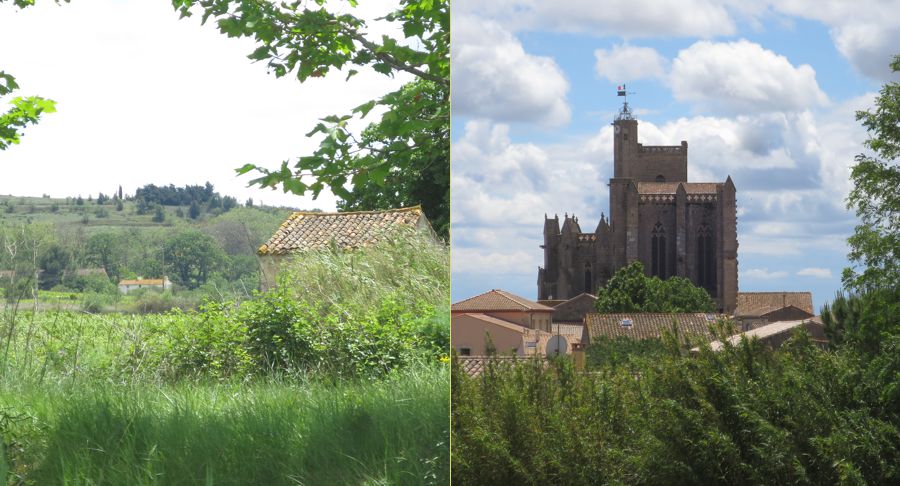| itinerary < 28 May Canal du Midi 30 May > | Canal du Midi 29 May 2016 |
|
We parked, literally, in the weeds, and this morning we were hosting considerable livestock, in the form of snails, crickets, and other assorted small fry. It rained heavily in the night, and we had a window open over the bed ...so we switched sides, and didn't have as good a night as the first on the boat (and yet, I should add, the best sleep of the trip yet: quiet, calm, gently rocking...) When we awoke, the sun was peeking through the clouds. From atop the berm beside the canal, looking south, the scene was bucolic. |
 |
 |
We navigated a couple of kilometers into Capestang, where there's a Sunday market. Coming into town, one of the oldest and smallest bridges makes life interesting for the big boats ... but for a narrowboat, even with a little side-wind, it was easy to thread the needle. I have become a Narrowboat Snob. The huge plastic skows and tubs speed along taking their more-than-halves out of the middle. The speed limit is 8 km/hour, but everyone, from the Canal Authority to the outfitters tell folks to go half that, and we do. Guess who doesn't. So let me tell you what's good about our narrowboat. It's reasonably new, Brit-built by the company that we rent from, steel bottom, wood top. The floor level is about a foot below the water level, so it's very stable, but shallow draft, too. |
 |
|
As you can see, it's six times as long as it is wide. The one we originally signed up for was having "exhaust trouble" and so we were given "an upgrade" to this supposedly four person boat ...but they'd have to be either very small persons, or four persons who really liked each other alot. The companionway – the hallway – is about 24" wide at floor level, but narrowboats pinch in toward the top, about a foot on either side, so one walks sideways. The galley (kitchen) is barely big enough to turn around in (if you're slim), but surprisingly well fitted out, as is everything on the boat: no wasted space! Bathroom ditto. Surprisingly, there's a shower. One steers from the back, meaning that one gets there 50 feet before one arrives ... so navigation requires thinking ahead. Getting through bridges and past the oversized plastic skows whose incompetent drivers hog the middle is fairly easy once one adapts to the tricks that perspective plays – there's usually more space than one thinks. Because, at four km/hr, a slow walking speed, you can almost count the clumps of grass along the bank, all that really needs doing to "hit your marks" steering is to think a hundred or so feet ahead. It's a bit like steering a knife: long and slender. It's quite surprisingly relaxing ...except mooring, which is tricky. The steerer at the stern can't see the bow (front) of the boat, but must project it. One's mate is at the bow, ready to step off onto the bank and hold the boat against the bank. Steering with a tiller means you push right to go left ...and you get where you're going, or stop, using the throttle. No brakes, so you stop the boat with a burst of reverse thrust – best not forget which direction reverse is when landing. (I had a problem with this in Capestang.) Once the bow is snug up against the bank, one can use the tiller and bursts of reverse and forward to nudge the stern toward shore. I think I can safely say that we will get better at mooring ...and we could be worse. Emily, our teacher, said, "Don't worry, you can't hurt the narrowboat. But try not to run into the plastic boats, because if you do, you win." |
|
Capestang on market day (or, I'm guessing, any other day) is a hotbed of plastic skows and tubs. I'm going to try to control my contempt. But really...
|
 |

|
 |
The wind picked up after lunch, but our sturdy little boat managed well (until it was time to moor; mooring is a bitch! just like on a river in a canoe!) and we headed across more beautiful countryside. She's holding the book of detailed maps we're using to know what's coming next. |
 Beautiful countryside, Capestang Cathedral |
|
Very near the end of the day, we passed through Malpas Tunnel, through a flinty ridge that almost brought the Canal to a permanent halt. The Royal Overseer headed to Paris for instructions, expecting to be told to pull the plug (or whatever the euphemism was then) but Riquet, the entrepreneur who imagined and then built the Canal, came up with the idea of a tunnel (there was only one previous canal tunnel in France) and called in all his workers, so that by the time the Overseer returned with the stop-work order, the Canal was already on the other side of the obstacle. Poor Riquet died six months before water flowed in the Canal, but he is still fondly remembered by the French as the builder of "the greatest engineering feat since the Pyramids." All the books say the tunnel is quite a challenge, but not for our boat. The tub behind us was happy to slow down and follow us through. |
 |
 |
updated 18 November 2024 Caspar Time site software and photographs by the Caspar Institute except as noted this site generated with 100% recycled electrons! send website feedback to the CI webster © copyright 2002-2024 Caspar Institute |